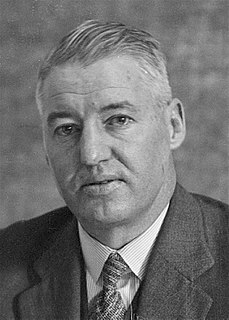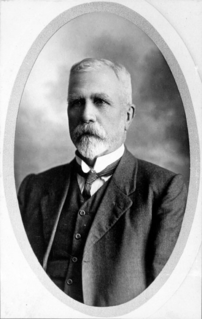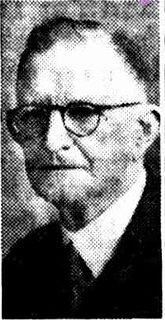
Arthur Edward Moore was an Australian politician. He was the Country and Progressive National Party Premier of Queensland, from 1929 to 1932. He was the only Queensland Premier not to come from the ranks of the Labor Party between 1915 and 1957. Although successful in achieving the unity of the conservative forces in Queensland for an extended period, Moore's abilities were tested by the onset of the Great Depression and like many other governments in Australia and elsewhere his was unable to endure the formidable challenges it posed.

Crawford Vaughan was an Australian politician, and the Premier of South Australia from 1915 to 1917. He was a member of the South Australian House of Assembly from 1905 to 1918, representing Torrens (1905–1915) and Sturt (1915–1918). Elected for the United Labor Party, he served as Treasurer in the Verran government, succeeded Verran as Labor leader in 1913, and was elected Premier after the Labor victory at the 1915 state election.
This is a list of members of the 18th Legislative Assembly of Queensland from 1909 to 1912, as elected at the 1909 state election held on 2 October 1909.

Elections were held in the Australian state of Queensland on 22 May 1915 to elect the 72 members of the state's Legislative Assembly.
The Ryan Ministry was the 27th ministry of the Government of Queensland and was led by Premier T. J. Ryan of the Labor Party. It was the first majority Labor government in Queensland's history. It succeeded the Denham Ministry on 1 June 1915, following the latter's defeat at the 1915 state election on 22 May. It was succeeded by the Theodore Ministry on 22 October 1919 following T. J. Ryan's resignation from the Queensland parliament to run for federal politics.

Elections were held in the Australian state of Queensland on 12 May 1923 to elect the 72 members of the state's Legislative Assembly. The Labor government was seeking its fourth continuous term in office since the 1915 election; it would be Premier Ted Theodore's second election.

Elections were held in the Australian state of Queensland on 8 May 1926 to elect the 72 members of the state's Legislative Assembly. The Labor government was seeking its fifth continuous term in office since the 1915 election. William McCormack was contesting his first election as Premier.
This is a list of candidates who stood for the 1920 Queensland state election. The election was held on 9 October 1920.

Elections were held in the Australian state of Queensland on 9 October 1920 to elect the 72 members of the state's Legislative Assembly. The Labor government was seeking its third term in office since the 1915 election. It was Premier Ted Theodore's first election.
This is a list of candidates who stood for the 1915 Queensland state election. The election was held on 22 May 1915.

The Holman ministry or Second Holman ministry or Holman Nationalist ministry was the 36th ministry of the New South Wales Government, and was led by the 19th Premier, the Honourable William Holman, MLA.

William Lennon was a politician in Queensland, Australia. He was a Member of the Queensland Legislative Assembly and a Member of the Queensland Legislative Council. He was Lieutenant-Governor of Queensland.

Herbert George McPhail was a member of both the Queensland Legislative Council and Queensland Legislative Assembly.

Sir Edward Henry Macartney was a solicitor, company director and a member of the Queensland Legislative Assembly.
The Liberal Party was a political party in the Australian state of Queensland in the early 20th century. It combined the main non-Labor forces, the "Kidstonites" of William Kidston and the Conservatives of Robert Philp, similar to the federal Commonwealth Liberal Party whose fusion it preceded. The Liberals held government from their formation in 1908 until defeat in 1915 after which they combined with other elements in the state to form the National Party.















